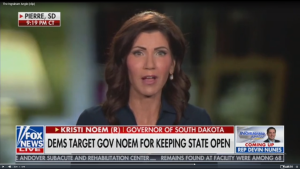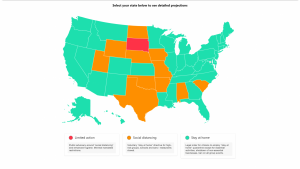Noem’s big move
South Dakota’s governor intends for her state to lead the charge in the new conservative movement—during COVID-19 and beyond
Governor Kristi Noem speaks at a Turning Point USA convention in West Palm Beach, Florida. The governor has become increasingly active in the conservative world, appearing on podcasts and developing connections with high-profile Trump officials.
May 15, 2020
In early April, national anxieties about the COVID-19 outbreak reached a new high. The Surgeon General made headlines on Fox News Sunday with his claim that “This is going to be our Pearl Harbor moment, our 9/11 moment, only it’s not going to be localized.” At least 13,883 people lost their lives that week, the highest total to date, according to the Center for Disease Control.
In South Dakota, Governor Kristi Noem has been facing increasing criticism due to her decision to not issue the statewide lockdown that was common across other states. Noem maintained that a stay-at-home order was not right for South Dakota.
“The calls to apply for a one-size-fits-all approach to this problem in South Dakota is herd mentality; it’s not leadership,” Noem told reporters during an April 1 press briefing.
Noem emphasized the need for South Dakotans to make their own decisions or take “personal responsibility.” However, she also faced increasing pressure from Sioux Falls mayor Paul Tenhaken to issue a state or county-wide order, as Sioux Falls laws meant that such a lockdown would require a seven-day delay to take effect.
“Quite honestly it’s crap that we have to wait that long to act,” said Tenhaken in mid-April according to the Argus Leader.
On a national level, Noem’s narrative stuck a chord, drawing attention from both sides of the increasingly partisan divide over the nation’s COVID-19 response. On one side, conservative commentators cheered the governor’s strong resolve against liberal voices calling for more authoritarian measures. On the other side, voices in the liberal media criticized Noem’s limited intervention as a reflection of the Trump administration’s overall response—too little, too late.
Noem’s critics’ moment came when one (now famous) pork processing plant became the biggest national hotspot for coronavirus cases. The Washington Post was quick with the headline: “South Dakota’s governor resisted ordering people to stay home. Now it has one of the nation’s largest coronavirus hot spots.”
The Smithfield outbreak appeared to confirm a narrative that had been held by Noem’s critics for a long time: the loose approach to this pandemic has weakened South Dakota’s response, possibly costing lives in the process. One popular image shared among LHS students is a map of the U.S. from the website Covid Act Now, a project that is designed to help state and local governments make decisions in reaction to the virus. The graphic showed South Dakota as the sole state with “limited action.” The website, as of March 26, had a clear warning: “To prevent hospital overload, Shelter in Place must be implemented by: April 5 to April 10.”

(Washington Examiner)
Noem, meanwhile, stood by her decision to not issue a stay at home order. The governor was cheered on by conservative media for her stance. The Washington Examiner reported on an interview that Noem did with Fox’s Laura Ingraham, who praised her ethos.
“South Dakota governor Kristi Noem is refusing to devastate her state’s economy and ruin people’s lives by imposing a lockdown,” said Ingraham. “That’s obviously made her Public Enemy Number One for the liberal media.”
In the interview, Noem characterized the media attention from publications like The Washington Post as unfair, pointing out that the Smithfield plant would have stayed open despite a stay-at-home order due to its crucial role in the American food supply chain.
“… on the national level…they’ve been not telling all the facts behind this,” said Noem. “The people of South Dakota can be trusted to make good decisions. We have common sense.”
That trusty ‘South Dakota common sense,’ and Noem’s overall messaging just happen to fall into line with the narratives told by one much more influential Republican: President Trump. Noem has been a consistent supporter of Trump, who regularly decries the ‘oppressive left-wing media,’ the ‘destructive liberal agenda’ and ‘incursions against the Constitution.’ One article by local Associated Press reporters pointed to Noem’s continued contacts with high-profile Trump officials as a sign that the governor has higher aspirations than state office. Noem’s Senior Advisor, Maggie Seidel, fired back at the piece, claiming in an email to local journalists that the article gives too little attention to how “Noem has leveraged her relationships in Washington to improve the situation on the ground here in South Dakota.” The email echoed the combative attitude that the president has taken with the press throughout his term. Seidel cited an article from The Federalist titled “Media Attack Gov. Kristi Noem For Not Panicking And Destroying Her State” as “good journalism,” similar to the president’s (currently less frequent) habit of praising Fox News for its right-leaning coverage.
The AP piece, although perhaps a bit speculative, alluded to one important fact: South Dakota, in many ways, is emerging as a prominent example of how the Trump presidency is changing American politics. National media coverage of Noem seems to suggest that what she’s saying, doing and not doing resonates with many members of the Trump movement that has radically transformed the Republican party.
Beyond run-ins with the media, her background appears to reflect other aspects of the Trump ideology. Noem infamously finished her undergraduate degree while serving in the U.S. House of Representatives. At the age of 22, Noem paused her education to help run her family’s farm after her father lost his life in a grain silo accident. Her nontraditional education coincides with the president’s resistance towards academia and the overall idea that with the proper set of beliefs and the right amount of confidence, a New York businessman (or South Dakota farmer) can run the executive better than any entrenched career bureaucrat with a Juris Doctorate or M.P.P.

For now, it appears as if the governor’s “against the grain” approach has been vindicated. Those Covid Act Now predictions from March? They severely overestimated hospitalization rates, claiming that 4,231 people would need a hospital bed by April 20—the total for South Dakota cases sits at under 4,000 total cases. And Mayor Tenhaken? He was often cited by commentators as proof that Noem is ignoring the wishes of her own state, yet now he is backpedaling, claiming that the governor was right all along.
The full effects of states’ decisions surrounding the U.S. COVID-19 pandemic are still unknown. Critics repeatedly hit Florida’s governor for his less-than-decisive action on the virus, but some commentators have noted that his state’s numbers paint a positive picture, and that reopening beaches and parks might not be so crazy. Currently, Noem is facing criticism for her own “Back to Normal” plan. One Argus Leader editorial lampooned the governor’s unspecific guidance and “laissez faire tactics.” In the coming weeks, Noem will have to defend her decisions regarding preparing for and combatting the outbreak. The most contentious point will likely be the Smithfield plant. Some voices will likely argue that the state government could have acted earlier to manage a situation where over 800 workers contracted the virus, a large percentage of which have limited financial resources.
As state governments ponder the move towards reopening, it feels as if the country is slowly getting back to normal. The president has begun what’s been dubbed his “Mueller revenge play,” the House is arguing about whether to include banking protections for weed companies in the newest relief bill and young people would really prefer a different Democratic nominee. With the return to normal will naturally come squabbles about the conduct of the U.S. government during the pandemic. However, for Americans, there will never be a return to normalcy, at least in terms of the norms that have defined U.S. politics for the past few decades. ‘Normal’ died in 2016. We are moving into a new era of American government, one that is driven by people who never reaped the benefits of 20th-century politics. On the red side, Governor Noem, with her devotion to Trumpian ideology, evidently wants South Dakota to be on the forefront.
It should be noted that the Covid Act Now website clearly acknowledges the limitations of projects that seek to model the spread of diseases like COVID-19. This article is a good summary of the project’s background, as well as providing some information about South Dakota.









